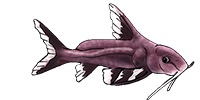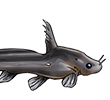Corydoras venezuela
-
Manoah
- Posts: 104
- Joined: 06 Mar 2023, 11:59
- My aquaria list: 2 (i:0)
- Location 1: Netherlands
- Location 2: Netherlands
- Interests: Biotope aquariums, corydoras sp, south american nature
Corydoras venezuela
Hi there,
Does anyone, maybe shane, have fotos of the habitat of the location corydoras schultzei black lives in the llanos?
Does anyone, maybe shane, have fotos of the habitat of the location corydoras schultzei black lives in the llanos?
- bekateen
- Posts: 9743
- Joined: 09 Sep 2014, 17:50
- I've donated: $40.00!
- My articles: 4
- My images: 144
- My cats species list: 148 (i:107, k:33)
- My aquaria list: 37 (i:14)
- My BLogs: 46 (i:157, p:2650)
- My Wishlist: 36
- Spotted: 186
- Location 1: USA, California, Stockton
- Location 2: USA, California, Stockton
- Contact:
Re: Corydoras venezuela
Exactly.Ron.H wrote: 02 Mar 2024, 21:21 corydoras schultzi black is a man made variant. they do not exist in the wild
Find me on YouTube & Facebook: http://youtube.com/user/Bekateen1; https://www.facebook.com/Bekateen
Buying caves from https://plecocaves.com? Plecocaves sponsor Bekateen's Fishroom. Use coupon code bekateen for 15% off your order. Also, for you Swifties: Https://youtu.be/ZUKdhXL3NCw
-
Manoah
- Posts: 104
- Joined: 06 Mar 2023, 11:59
- My aquaria list: 2 (i:0)
- Location 1: Netherlands
- Location 2: Netherlands
- Interests: Biotope aquariums, corydoras sp, south american nature
Re: Corydoras venezuela
But in shanes venezuela dairy he tells about catching these in the llanos. So??Ron.H wrote: 02 Mar 2024, 21:21 corydoras schultzi black is a man made variant. they do not exist in the wild
- Jools
- Expert
- Posts: 16313
- Joined: 30 Dec 2002, 15:25
- My articles: 198
- My images: 949
- My catfish: 237
- My cats species list: 88 (i:235, k:2)
- My BLogs: 7 (i:10, p:167)
- My Wishlist: 23
- Spotted: 453
- Location 1: Middle Earth,
- Location 2: Scotland
- Interests: All things aquatic, Sci-Fi, photography and travel. Oh, and beer.
- Contact:
Re: Corydoras venezuela
No, he doesn't, he talks about this: . Don't worry, you are not the first to be confused by this!
Jools
Owner, AquaticRepublic.com, PlanetCatfish.com & ZebraPleco.com. Please consider donating towards this site's running costs.
-
Manoah
- Posts: 104
- Joined: 06 Mar 2023, 11:59
- My aquaria list: 2 (i:0)
- Location 1: Netherlands
- Location 2: Netherlands
- Interests: Biotope aquariums, corydoras sp, south american nature
Re: Corydoras venezuela
Jools wrote: 03 Mar 2024, 11:00
Oh tanks,
Thats probably a darker variation of the c.Schultzei? Or c.venezuelanus?
No, he doesn't, he talks about this: . Don't worry, you are not the first to be confused by this!
Jools
- Shane
- Expert
- Posts: 4650
- Joined: 30 Dec 2002, 22:12
- My articles: 69
- My images: 162
- My catfish: 75
- My cats species list: 4 (i:75, k:0)
- My aquaria list: 4 (i:4)
- Spotted: 99
- Location 1: Tysons
- Location 2: Virginia
- Contact:
Re: Corydoras venezuela
C. schultzei is from a completely different river system in Peru.
C. venezuelanus is restricted to the Tuy and Valencia basins.
C. sp. llanos is found south of the Andes in the northern llanos of Venezuela. As one travels further south in the llanos it disappears and is replaced by C. concolor.
I am unsure if it is more closely related to C. venezuelanus or if its just a much darker northern population of C. concolor. When first caught they are a bright, metallic green reminiscent of wild C. (Brochis) splendens. After they settle in the metallic sheen disappears and the fish become dark in coloration.
The current C. venezuelanus available in the hobby was taken from a population near Bejuma and "imported" to Germany in baby food jars in 2000. I do not know the specific German aquarist that received this one time "import" but they bred them and the fish spread through the hobby. There are now even several deformed versions available selling under various trade names such as "Orange sailfin" and "red sailfin."
I do not believe C. sp llanos has ever been taken outside of Venezuela.
-Shane
C. venezuelanus is restricted to the Tuy and Valencia basins.
C. sp. llanos is found south of the Andes in the northern llanos of Venezuela. As one travels further south in the llanos it disappears and is replaced by C. concolor.
I am unsure if it is more closely related to C. venezuelanus or if its just a much darker northern population of C. concolor. When first caught they are a bright, metallic green reminiscent of wild C. (Brochis) splendens. After they settle in the metallic sheen disappears and the fish become dark in coloration.
The current C. venezuelanus available in the hobby was taken from a population near Bejuma and "imported" to Germany in baby food jars in 2000. I do not know the specific German aquarist that received this one time "import" but they bred them and the fish spread through the hobby. There are now even several deformed versions available selling under various trade names such as "Orange sailfin" and "red sailfin."
I do not believe C. sp llanos has ever been taken outside of Venezuela.
-Shane
"My journey is at an end and the tale is told. The reader who has followed so faithfully and so far, they have the right to ask, what do I bring back? It can be summed up in three words. Concentrate upon Uganda."
Winston Churchill, My African Journey
Winston Churchill, My African Journey
-
Manoah
- Posts: 104
- Joined: 06 Mar 2023, 11:59
- My aquaria list: 2 (i:0)
- Location 1: Netherlands
- Location 2: Netherlands
- Interests: Biotope aquariums, corydoras sp, south american nature
Re: Corydoras venezuela
Shane wrote: 03 Mar 2024, 14:35 C. schultzei is from a completely different river system in Peru.
C. venezuelanus is restricted to the Tuy and Valencia basins.
C. sp. llanos is found south of the Andes in the northern llanos of Venezuela. As one travels further south in the llanos it disappears and is replaced by C. concolor.
I am unsure if it is more closely related to C. venezuelanus or if its just a much darker northern population of C. concolor. When first caught they are a bright, metallic green reminiscent of wild C. (Brochis) splendens. After they settle in the metallic sheen disappears and the fish become dark in coloration.
The current C. venezuelanus available in the hobby was taken from a population near Bejuma and "imported" to Germany in baby food jars in 2000. I do not know the specific German aquarist that received this one time "import" but they bred them and the fish spread through the hobby. There are now even several deformed versions available selling under various trade names such as "Orange sailfin" and "red sailfin."
I do not believe C. sp llanos has ever been taken outside of Venezuela.
-Shane
Thank you so much. So corydoras concolor does occur in the llanos? I tought more south near amazonas state in venezuela. How would its habitat look like? Plants?
- Shane
- Expert
- Posts: 4650
- Joined: 30 Dec 2002, 22:12
- My articles: 69
- My images: 162
- My catfish: 75
- My cats species list: 4 (i:75, k:0)
- My aquaria list: 4 (i:4)
- Spotted: 99
- Location 1: Tysons
- Location 2: Virginia
- Contact:
Re: Corydoras venezuela
That is the thing with holotype locations. They represent a single point of discovery only. In the case of C. concolor the ho!otype location is actually the very southern edge of their range in the wild.
For a llanos tank it all depends if you want to recreate the wet season or dry season. Wet season would be aquatic or emersed plants replicating a flooded area of grassland. Dry season would be no plants with leaf litter over a sand substrate and driftwood representing downed trees and roots exposed from the river bank.
-Shane
For a llanos tank it all depends if you want to recreate the wet season or dry season. Wet season would be aquatic or emersed plants replicating a flooded area of grassland. Dry season would be no plants with leaf litter over a sand substrate and driftwood representing downed trees and roots exposed from the river bank.
-Shane
"My journey is at an end and the tale is told. The reader who has followed so faithfully and so far, they have the right to ask, what do I bring back? It can be summed up in three words. Concentrate upon Uganda."
Winston Churchill, My African Journey
Winston Churchill, My African Journey
-
Manoah
- Posts: 104
- Joined: 06 Mar 2023, 11:59
- My aquaria list: 2 (i:0)
- Location 1: Netherlands
- Location 2: Netherlands
- Interests: Biotope aquariums, corydoras sp, south american nature
Re: Corydoras venezuela
Shane wrote: 04 Mar 2024, 16:17 That is the thing with holotype locations. They represent a single point of discovery only. In the case of C. concolor the ho!otype location is actually the very southern edge of their range in the wild.
For a llanos tank it all depends if you want to recreate the wet season or dry season. Wet season would be aquatic or emersed plants replicating a flooded area of grassland. Dry season would be no plants with leaf litter over a sand substrate and driftwood representing downed trees and roots exposed from the river bank.
-Shane
Well i am making a morichal. With little plants. Only a bit of najas sp. I already have some c.aeneus, c.brevirostris and a few cardinals. Morichals maintain their water all year round so plants would be possible i guess in a dry season set up. Corydoras simulatus occurs more west right? Near the meta? Could they also occur in the llanos?





 sp`llanos`/g/s/1.jpg)